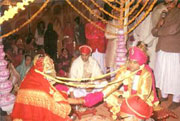THE MARRIAGE CEREMONY OF THE MARWADIS
Pre Wedding
Pithi Dastoor

The Pithi Dastoor ceremony follows which involves the
bride/groom and continues until the day of the wedding. The actual ceremony
consists of application of turmeric and sandal wood paste to the bride/ groom
who cannot leave the house once the pithi starts. The pithi dastoor at the
bride's house is an elaborate affair.
The bride dresses in an orange
Rajasthani dress and is then brought under a silken canopy, which is held up
with swords at four corners by four ladies who must belong to the same clan as
the bride. She is brought to the ladies gathering, who then apply the paste to
her. A similar ceremony takes place at the groom's place as well, although it is
not that elaborate.
Mehfils
Mehfils are an integral part of every Rajasthani wedding. It is
usually held in the evenings, they are again segregated into the 'ladies mehfil'
and the 'gents mehfil'. At the ladies' mehfil, all the women gather at a central
place in an enclosed courtyard or hall.
In dazzling dresses, they perform
the ghoomar (a special dance done in a group). The bride at the mehfil is given
an important position to sit and watch the proceedings. If the ladies' mehfil is
in progress at the groom's house, then only the groom is privileged to attend
the all-women affair. Of course, the men have their own mehfil, where singers
perform and these are strictly all male parties.
Janev
In the Janev ceremony, the sacred thread is given to the would-be
groom on the eve of his becoming a house-holder. The groom has to be dressed in
saffron robes like an ascetic and perform a havan before wearing the thread.
Palla Dastoor
On the day of the actual wedding, or maybe a day prior
to it, the Palla Dastoor is brought in by a few of the groom's relatives,
accompanied by family retainers, to the bride's house.
The palla dastoor
consists of clothes, jewelry and gifts from the groom, which the bride has to
wear during the wedding ceremony. This particular custom is typical to the
Rajputs. The traditional Rajasthani wedding dress is usually red, but it could
also be orange, gold, yellow, or pink. In certain Rajput clans, a bright parrot
green is also worn.
Baraat
A Rajput baraat consists entirely of male members. The bridegroom is
usually dressed in a gold achkan, with an orange turban and a churidar or
jodhpurs with jootis. The baraat members also must wear achkans or sherwanis
with jodhpurs and safas. All members, including the groom who rides an elephant
or a horse, carry swords.
Wedding
Aarti
As soon as the actual wedding ceremony begins the groom is taken
inside to the ladies section where he is received by the bride's mother with the
traditional aarti, and then taken to the mandap to perform the actual wedding rituals.
The bridegroom has to be accompanied only by a male member of the family, either a married
relative or his younger brother or a younger male cousin.
The bride must keep her
face covered throughout the wedding ceremony.
While the wedding is in
progress, the baraat is entertained outside by the bride's male family members.
Therefore, it is mostly the women members of the bride's family who attend the
wedding ceremony.
Post Wedding
Bidai
However at the time of the bidai, a coconut is placed under
the wheel of the car before the bride lifts her veil for the husband after the
wedding. At this stage, the groom usually gives a piece of jewelry to his bride.
Grihapravesh
After the bride reaches the groom's house Grihapravesh
takes place. The bride still wears the veil while the puja and other ceremonies
take place. A few games are played between the bride and the groom.
Pagelagni
The day following the grihapravesh, the pagelagni takes
place. This is a ceremony where the bride, still in veil, is formally introduced
to all the family members of the groom who bless her and give her gifts. The
veil is then finally removed.
|


